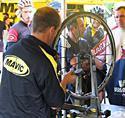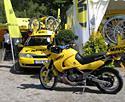
Recently on Cyclingnews.com |
91st Tour de France - July 3-25, 2004
Tour tech - July 14, 2004
Edited by John Stevenson
Got tech? Send press releases, news, and tech questions to the Cyclingnews tech-heads.
|
|
|
Shimano confirms carbon
Shimano has officially confirmed that the carbon wheels that have been spotted on several of its sponsored riders' bikes this year in the Tour and elsewhere are 2005 Dura-Ace WH-7800 carbon wheels.
Used by pro teams including T-Mobile, Gerolsteiner and Credit Agricole this year, the WH-7800 carbons will be available to the rest of us in early 2005. Shimano is claiming 1290g/pair, which is a dramatic improvement over the 1473g for Shimano's previous carbon wheels, the WH-7701s. (And we hasten to add that we only say 'claimed' because we haven't actually weighed a set ourselves - the weights Shimano quotes for its components are usually right on the money.)
Some of the savings doubtless come from the use of evenly-spaced spokes as in the Dura-Ace WH-7800 clincher rims. Regular spoking allows a lighter rim because it doesn't need to be super-stiff to cope with the long unsupported spans involved in paired spoking. The new wheels use the new Dura-Ace hub design with an aluminium axle, which also sheds grams.
Shimano is also working on wheels for the new tubeless tyres that several tyre manufacturer, including Michelin and Hutchinson, have in development. We'll see details of these at the August and September round of trade shows.
Ten-speed hubs of course - in the carbon Dura-Ace wheels
Neutral support wheel deal
|
|
|
One of the hardest-working groups of people at the Tour are the yellow-clad folks from Mavic who provide neutral technical support for the riders.
Cheryl and Marco Biagini from Canada asked about a detail of the tech support job. "Every team has it's own support car," they write, "So when one of their men need a wheel change they know exactly the gears they are using so they just change wheel for wheel. With the neutral support vehicle how do they know what wheel the rider is using? I'm sure the top racers have their own clusters according to the style they ride. So how does that happen?"
There are two variables that the Mavic guys have to deal with here. The simplest is whether riders are using Campagnolo or Shimano wheels, and that's dealt with by simply carrying rear wheels of both varieties. Since both manufacturers are now making ten-speed systems, the issue of the particular sprocket selection is less crucial than it used to be. On a flat stage, wheels with 11-21 sprockets will suit just about everyone, and similarly in the hills we'd expect tech support to just hand out 11-23s -- unless it's a very hilly day, in which case you're looking at time for the 12-25s.
Yellow widget mystery
Lots of readers have written to ask us what the yellow squares are on the Tour riders' bikes. They're transponders used by the race's results system to detect a rider as he crosses the line, massively speeding up the allocations of positions when the peloton finishes in one huge bunch.
Before the days of nifty electronics and computers, finish positions in races such as the Tour were determined by teams of eagle-eyed commissaires watching the finish, recently with help from cameras. Those commissaires are still there - nobody with any sense fully trusts an automated results system - but for the most part the Tour gets its results out incredibly quickly because the whole process is automatic.
Tyre topics
Reader Syd Wall wrote in to ask: "In motor racing and rallying, wet weather tyres are> indispensable, but I've never heard wet weather tyres mentioned in cycling. Wet weather bike tyres in the TTT conditions would have meant fewer crashes and more confidence and speed through the corners. Surely the riders would prefer them? What's the opinion of the riders and the tyre companies?"
Motorsport switches tyres in the wet because the vehicles use relatively wide tyres at low pressures and high speeds, compared to bikes. It's therefore necessary to use treaded tyres to prevent aquaplaning. But a bicycle tyre is about the same width as the tyre segment between the sipes of a wet-weather motorsport tyre, and runs at much higher pressure and lower speed. It therefore cuts through the water layer to the tarmac and doesn't aquaplane - in this regard, all bikes are already using wet weather tyres.
That said, regardless of tread pattern, some tread compounds definitely stick better than others to wet tarmac. I once spent a very fun evening riding round the city of York in a torrential downpour using completely slick tyres that happened to be made from a decently sticky compound - despite some fairly silly cornering antics I stayed up.
The big problem that Tour racers have had this year is that the roads haven't just been wet. Practically nothing will help when a road is coated with grime and slime from farm vehicles, or the diesel-engined cars and trucks that infest European cities.




